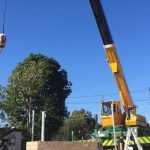
Can You Operate A Mobile Crane On Slopping Ground?
Working with mobile cranes on sloping ground introduces a unique set of challenges. Even slight slopes can drastically affect a crane’s stability, leading to rollovers that endanger operators, equipment, and surrounding personnel. But can you operate a mobile crane on sloping ground? The short answer is yes, but only under the right conditions and when operations strictly follow the manufacturer’s guidelines.
This post explores the risks associated with operating cranes on sloping ground and provides essential safety practices to mitigate these risks.
The Risks of Sloping Ground
Increased Roll Over Risk
Operating on a slope changes the working radius of the crane, affecting its stability. This can result in the crane overturning forward, backward, or sideways depending on the slope and crane configuration.
High Centre of Gravity
Mobile cranes with a high centre of gravity are particularly vulnerable on sloping ground. Factors that increase the risk include:
- High Luff Angles: Raising the boom to a steep angle increases instability.
- Telescoped Booms: Extending the boom raises the centre of gravity, heightening the risk of tipping.
- Heavy Suspended Loads: A combination of a high boom and a heavy load can severely compromise stability.
- Articulation: Articulated cranes are especially sensitive to ground angles due to their jointed design.
Minimal Slopes, Major Impact
Even slight slopes of 2–3 degrees can have a dramatic effect on crane stability. Soft ground, suspension movement, and pneumatic tyres can amplify the side angle of the crane, increasing the likelihood of overturning.
Best Practices for Operating Cranes on Sloping Ground
Prioritise Firm, Level Ground
Wherever possible, operate cranes on firm, level surfaces. This is the safest option to maintain stability and ensure efficient lifting operations.
Follow Manufacturer Guidelines
Always adhere to the manufacturer’s specifications, which detail the maximum slope angles a crane can safely manage. Operating beyond these limits increases the risk of instability.
Adjust Travel Direction
When travel on sloping ground is unavoidable:
- Move up or down the slope, rather than across it, to minimise rollover risks.
- Reduce speed and maintain smooth, controlled movements to avoid sudden shifts in the crane’s stability.
Minimise Load and Boom Angle
- Keep the boom as short and low as possible to lower the centre of gravity.
- Avoid lifting heavy loads that could further destabilise the crane on an incline.
Use Inclinometers and Monitoring Tools
- Side slope inclinometers can help monitor the crane’s tilt angle, though they may have limitations depending on the crane’s configuration.
- Continuously monitor the crane’s position and stability during operations to identify potential issues early.
Mitigate Soft Ground Risks
Slopes combined with soft ground present a dual hazard. Once a safe lift location is identified, use stabilising pads (see post photo with Demag AC 55 Ton crane in dual lift on slopped ground with a Franna pick and carry crane), timbers, or mats to evenly distribute the crane’s weight and minimise the risk of sinking or tipping.
Careful planning
Operating cranes on sloping ground requires careful planning, adherence to manufacturer guidelines, and constant vigilance. Even minimal slopes can significantly impact stability, making it essential to minimise risks through proper setup and safe operating practices. Avoiding slopes where possible and adopting safety measures when they are unavoidable will help ensure successful and secure crane operations.
Why Choose Mighty Cranes?
Mighty Cranes crane hire Brisbane offers professional crane hire services to meet the specific needs of your project. With a modern crane fleet and experienced operators, we ensure safe and reliable lifting operations—even in challenging conditions like sloping ground. Contact Mighty Cranes today at 0477 000 976 to discuss your requirements and find the right lifting solution for your project.




